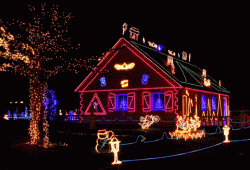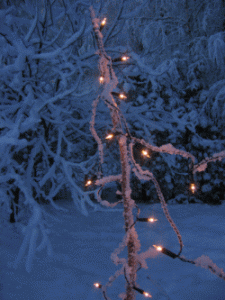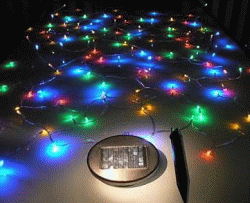Solar-Powered Christmas Lights: Power-Efficient Lighting for the Season
Solar powered Christmas lights provide increased flexibility and decreased power costs.
Solar powered Christmas lights can provide flexibility, while at the same time cutting down on your power costs. They also have the advantage of being automatic, meaning that, once they are installed, they will simply turn themselves on at night. This means that your home can be brightly lit at no energy cost, even when you are not at home.
Solar lights do have some disadvantages that should be taken into account, however. One is cost. Like any solar lighting, solar powered Christmas lighting depends on solar panels that cost more than traditional string lights would cost you. In addition, while solar panels are more flexible in terms of their location than string lights, they must be placed in direct sunlight. Finally, solar Christmas lights need to be winter ready in colder climates, increasing their cost.
Like most things, solar lights come in a wide variety of costs. In general, you should expect to pay no less than US$20 for a single string of lights, including a control board. This can increase to US$50 or more if you are looking for more powerful batteries. Because of weather, those in temperate climates will likely need to spend more on their solar lights.
How They Work
Solar powered Christmas lights operate quite differently than solar lighting that you might be used to. Most solar powered lighting includes a solar cell for each individual fixture. So, for example, if you have solar powered path lighting, each individual light will have its own panel on top of the fixture. This is why solar lighting is usually so flexible. You can put your solar lighting literally anywhere you want.

Christmas lights can create the illusion of a stenciled home.
Solar powered Christmas lights simply can’t work that way. If you had an individual solar panel for each of the individual lights, they would be prohibitively expensive, and you would need to make sure every single light is angled upwards.
Instead, solar powered Christmas lights work by using what is called a “control board”. These boards include a number of solar panels, usually four, and may include some basic controls for the lights themselves, affecting when the lights should turn on and for how long. This includes the ability to turn off the lights when you don’t wish to use them.
The control board includes a rechargeable battery, which stores electricity during the day. How much electricity is stored depends on the brightness of the day, but most control boards will at least allow for several hours of Christmas lighting each evening, even if the day is fully overcast.
The lights themselves are no different than traditional string Christmas lights. They are LED light fixtures, which are far more power efficient than incandescent lights, which would chew through the battery charge in a couple of hours.
Flexibility
Solar powered Christmas lights are a mix of flexibility and inflexibility, but understanding this mix will help provide the best Christmas lighting for your home. They provide wonderful flexibility in terms of where on your property they can be placed, but they require direct sunlight.

Cord limitations usually cause Christmas lights to hug the house.
On the one hand, solar lights are very flexible because they are untethered from your home’s electricity. Traditional string lights can only be placed next to electrical outlets, as those are your only source of power. This leads to the widespread use of such lights around the eaves of homes, as these are the only locations that provide ready access to outlets.
Notice, however, how rarely people light the trees in their yards. This is because it is very difficult to get power safely all the way out to landscaping details. Solar powered Christmas lighting can provide this sort of flexibility. The control boards can be placed anywhere on your property, including by landscaping, by fences or by anything else that you believe it would be attractive to illuminate.
On the other hand, the primary source of inflexibility is from the control boards themselves. Control boards only come with a limited number of lights, and they must themselves be placed in an area with direct sunlight. As a result, if you use a large number of solar powered Christmas lights, you will need to have a number of these control boards. Finding a large number of places to place control boards that have direct sunlight and will not be unsightly can be something of a task in itself.
One trick to providing maximum flexibility is to use traditional string lights for the areas around the house where outlets are available, but to use solar powered lighting for your landscaping details. This minimizes the cost of the Christmas lights, while allowing you to illuminate both your house and your landscaping.
Weather
Perhaps the most serious flaw with solar powered Christmas lights is their vulnerability to weather. The difficulty is that most rechargeable batteries don’t work well, if at all, in freezing temperatures. This leads many people in temperate climates to be very disappointed with their solar Christmas lighting, and may perhaps even turn them off of solar lighting completely.

Not all Christmas lights are suited to cold weather.
The problem is that in colder temperatures, rechargeable batteries work less and less well. They take longer to be charged and, once they are charged, they lose the charge much more quickly. Most batteries will simply stop working completely somewhere between -40ºF and 0ºF (-40ºC and -20ºC). As a result, if you are in a climate that routinely goes below 0ºF at night, you shouldn’t even bother with solar Christmas lights with current technology.
For those in temperate climates, this doesn’t mean that solar powered Christmas lights are worthless. However, you should be aware that you will not receive the amount of light that is advertised on the packaging. The amount of time that the packing says that solar lights will shine is how much they will shine with full, direct sunlight in above-freezing temperatures. In fact, you will get far less than what the packaging says, usually about twenty-five percent or less.
So, if you plan to use solar powered Christmas lights in a temperate winter, you should stay far away from the US$20 strings that give “up to 8 hours” of light. They will barely work, and their wires are often non-climate safe plastic to boot. Instead, you should be looking for batteries that provide at least 15 hours of charge and you should expect to pay about US$50 per string at minimum.
Putting It All Together

Solar Christmas lights usually come with strings of 50 to 100 LED lights. This kit is available at Amazon.
Solar powered Christmas lights have becoming popular in recent years because of their cost and flexibility:
- They are flexible because they are not tethered to your house or your sockets.
- However, they are inflexible because they require that the control board must be put in direct sunlight.
- They do not work very well in cold temperatures.
With all this information, you will find yourself in a better position for purchasing solar powered Christmas lights.
Back from Solar-Powered Christmas Lights to Solar-Powered Lighting
Back from Solar-Powered Christmas Lights to Home Lighting Tips